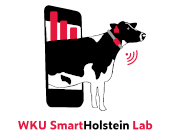
Genetic evaluations for type and production in the USA are calculated using animal model procedures. The animal model represents state-of-the-art methodology for calculating Predicted Transmitting Abilities (PTAs). The Holstein Association USA computes the genetic evaluations for type traits. PTAs for production traits, Somatic Cell Score, Productive Life, and Net Merit are calculated by the Council on Dairy Cattle Breeding (CDCB).
Animal model evaluations are based on the animal and its relationships to other animals being evaluated. Information from the animal itself, its ancestors and its progeny is incorporated, with all known relationships among the animals considered. Cow family information is utilized, including records of all female ancestors and all female descendants.
In an animal model evaluation, all identified relatives of an animal affect the animal's evaluation. Additionally, each animal influences the evaluations of its relatives. The amount of influence depends on how closely the animals are related. Daughters, sons and parents have greater impact on an animal's evaluation than do grandparents, cousins or other more remotely related animals.
Many factors affect milk and type records. Management, environment, and genetics all influence an animal's actual performance. These factors must be accounted for when estimating an animal's genetic merit. The following factors or effects are important when predicting genetic merit: 1) herd management effect, 2) genetic merit of mates, 3) genetic competition of herdmates, 4) environmental correlation between daughters of a sire in the same herd (sire-by-herd interaction) and 5) ancestor information.
When estimating an individual's genetic ability, the environment in which the cow performs must be accounted for. In addition, her actual records need to be adjusted for age and stage of lactation. Accounting for the non-genetic factors allows us to obtain a meaningful estimate of an animal's genetic merit.
Production records are standardized to account for the effects of age, season at calving, lactation number and days open in the previous lactation. All records are standardized to a 2X, 305-day, mature equivalent basis. Records less than 305 days in length are extended to a 305-day basis. A lactation record is included in the evaluation if the days in milk are at least 40 days. For a cow that died or was sold for any reason except for dairy purposes, her record will be included in the evaluation if she was in milk at least 15 days.
The effects of age and stage of lactation on final score and the linear traits at the time of classification are included as a routine calculation in the animal model. This procedure for standardizing classification scores to a constant age and stage of lactation basis ensures that the adjustment factors are up-to-date in each genetic evaluation.
Table 1. Characteristics of Animal Model genetic
evaluations for production and type
Characteristics |
Production |
Type |
|
|
|
Sires to progeny |
Yes |
Yes |
|
Dams to progeny |
Yes |
Yes |
|
Sons to parents |
Yes |
Yes |
|
Daughters to parents |
Yes |
Yes |
|
Yes |
Yes |
| |
|
Cows born in 2015 |
Cows born in 2015 |
|
Management groupb |
Required cows based on
classification option |
| |
|
Yes |
Yes |
| |
|
1-5 lactations |
All scores up to and including first permanent
scoredd, e |
| |
|
|
|
Parents of males |
Yes |
Yes |
|
Parents of females |
Yes |
Yes |
|
Daughters of males |
Yes |
Yes |
|
Daughters of females |
Yes |
Yes |
|
Sons of males and females |
Yes |
Yes |
| The genetic base is defined as all evaluated
cows born in 2015. The average PTAs of cows born in 2015 are zero (0) for milk, fat, protein and type. Base changes will be made every five years. |
| |
| The management group for production PTAs are
all cows calving within 2-month fixed intervals within a given herd and
year. In addition, the management groups consider registry status (registered
or grade) and lactation number (first or later). If fewer than five lactation
records are in a management group, management groups are combined to obtain
enough cows for a meaningful comparison. In PTA calculations for type traits,
all required cows classified in the herd on the given classification date
are included in the herdmate grouping. |
| |
In the Animal Model, a cow's records are
used in evaluating ancestors and progeny only if the cow's first record
is available. For production, the first record is the cow's first lactation.
A cow must have a score from a classification done prior to her reaching
43 months of age to qualify as having a first type traits record.
For production tested and/or classified cows with no first record, a supplemental
evaluation is done to estimate their genetic merit. Their records influence
their own PTAs but do not affect the evaluations of their relatives. Information
from relatives is considered in the evaluations of these cows. |
| |
| Classification scores are excluded
from genetic evaluations if the cow was classified as an Optional animal
based on the classification option. |
| |
| To be assigned a permanent score, a cow must
be five years of age or older at classification. |




